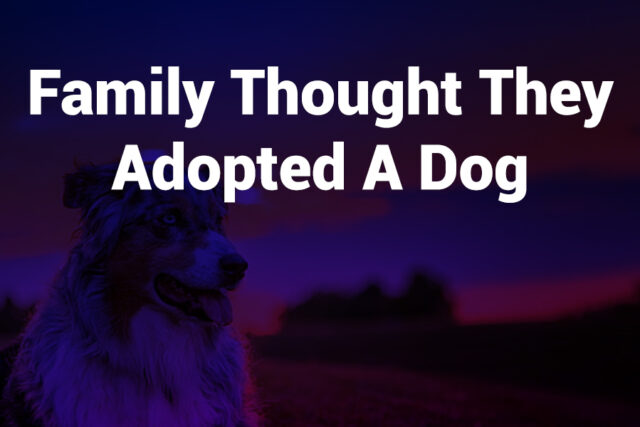When you bring home what you believe is a dog, you expect familiar behavior, predictable growth, and established norms. But sometimes things turn strange: the animal looks like a puppy yet seems not quite right.
Across the United States and worldwide, stories emerge of families who thought they adopted a dog, only to discover later that the truth diverged significantly. In this article, you’ll learn why such mix-ups occur, how to spot warning signs, and what you should do to protect your family and your new pet.
Why Families Sometimes Mistake Other Animals for Dogs
You might wonder how a scenario like this can occur at all. One common factor is that young wild animals—fox kits, coyote pups, certain hybrids—can resemble puppies of domestic dog breeds just enough in size, fur, and general shape.
Another factor is online marketplace adoption or private sales where documentation is weak or non-existent. With more than 40 percent of pet scams rising in recent years as buyers shift to digital adoption and classifieds, the risk of misidentification is higher than many realize.
Unlicensed breeders and exotic-pet traders sometimes market wild or hybrid animals as rare dog breeds, taking advantage of buyers’ lack of knowledge. In other cases, passionate adopters rescue from informal sources and assume the animal is a dog.
Lack of breed knowledge also plays a role. If you have limited experience with dogs, especially rare or mixed breeds, you may not notice differences in skull shape, body proportions, ear set, or behavior until the animal matures and the mismatches become apparent.
The Most Common Animals Mistaken for Dogs
Foxes
Red fox or Arctic fox kits have large ears, long muzzles and striking coats. At eight weeks and under, a fox kit may appear puppy-like. Families who find them abandoned may adopt them, believing they are a domestic dog breed.
Coyotes
Coyote pups, especially in suburban areas, may be confused with shepherd-type mixes. Their early size and coloration can mislead well-intentioned adopters. Over time, though, their behaviors-—heightened prey drive, nocturnal habits—diverge from typical dog norms.
Wolfdogs (Wolf-Dog Hybrids)
These are among the most complex cases. Wolf-dog hybrids get marketed as huskies or malamutes. Without licensed breeding records or DNA verification, buyers may adopt believing they have a domestic dog, later discovering an unstable temperament or unusual growth.
Raccoon Dogs and Other Exotic Canids
In some parts of the world, raccoon dogs (a wild East Asian species) are sold as dog breeds. The confusion arises from superficial dental and ear‐shape similarities. American exotic-pet trafficking occasionally brings these into the U.S., posing significant risk.
Mixed Wild Hybrids
Finally, hybrids between wild canids and domestic breeds further blur lines. These animals often inherit wild traits—high energy, lack of trainability, unusual diet—that clash with domestic dog expectations.
Signs the Animal You Adopted Might Not Be a Dog
You adopted the animal believing it was a dog—but something feels “off.” Here are signs you should watch for:
Growth pattern not matching typical domestic breeds (too fast, too large, unusual proportions)
• Vocalizations that differ from a dog’s bark or whine (howling, shrieking, unusual yelps)
• Distinct odor or oily coat texture that doesn’t resemble dogs you’ve known
• High prey drive or unprovoked aggression towards small animals or birds
• Excessive digging, climbing, or escaping behaviors uncommon in well-socialized dogs
• Avoidance of human touch or lack of desire for typical dog affection
• Eating habits or diet requirements that seem exotic or odd for a dog
Many U.S. veterinarians report more cases in recent years where clients buy a puppy then realize only months later that it behaves unlike a dog or continues to mature beyond expected size.
How Professional Shelters Identify Dogs Correctly
When you adopt from a licensed U.S. shelter, the verification process often includes:
Physical examination by a veterinarian who checks dentition, ear set, tail carriage, and body structure for breed conformity
• Health and vaccination records plus microchip scanning
• In some cases, DNA testing to identify breed mix or ancestor species
Responsible shelters rarely misidentify animals because they follow protocols and comply with state regulations. Most mistaken adoptions happen through private sellers or unregulated online marketplaces.
If you go the private-seller route, you should ask for documented proof of parent animals, see adoption records, and ideally request a DNA test.
What You Should Do If You Realize Your Pet Is Not a Dog
If you come to the slow realization that your adopted “dog” might not be a dog, act promptly and responsibly.
- Contact a local licensed wildlife rehabilitator or animal control agency. They can assess the animal’s species and needs.
- Avoid trying to train or domesticate the animal yourself if it shows wild traits. These animals often require specialized care and housing.
- Do not abandon the animal outdoors. That creates risk for wildlife, you, and the animal itself.
- Follow your state’s wildlife laws. Many U.S. states prohibit ownership of wild animals or hybrids without permits.
- If necessary, relinquish the animal to a sanctuary or facility equipped to handle exotic or wild species.
Wildlife centers in the U.S. now see hundreds of misidentified pets annually—animals originally bought or adopted as “dogs” that outgrow homes or reveal dangerous behavior.
How to Avoid Adopting the Wrong Animal in the First Place
To protect yourself, your family, and your prospective pet, follow this checklist:
Adopt from licensed U.S. shelters or rescue groups with full documentation
• Request and review health records, vaccination history, and microchip information
• Ask for clear photos of the animal’s parents and littermates if from private seller
• Be wary of extremely low-price offers for “rare breeds” or exotic pets
• Verify the seller’s identity and check for licensing or prior complaints
• Consider a DNA test if the breed is unusual or the animal shows early signs of abnormal behavior
• Observe the animal for several days in your home setting before making final commitment
Adopting a pet is a lifelong decision. Ensuring you truly know what you’re bringing home creates a safer outcome for everyone involved.
Real Cases That Help You Understand the Issue Better
Here are real-life situations that highlight what can happen:
A family adopted what they believed was a Tibetan mastiff puppy. After two years, the animal kept growing and refusing to act like a dog. It later turned out to be an Asiatic black bear.
• Another household took in a fox-kit believing it was a Japanese spitz. The animal exhibited wild behavior, climbing fences and avoiding touch, prompting intervention by wildlife officials.
• A private seller marketed a wolfdog cross as a purebred malamute. The family struggled with behaviour and learned the hard way through DNA testing.
In each case, the root cause was weak verification, seller misrepresentation or lack of knowledge. Importantly, these examples underscore that even well-meaning families and adopters can get caught up in situations beyond their expertise.
Final Thoughts
When you bring a pet into your home, you hope for companionship, joy, and shared memories. But if that animal turns out not to be a dog, you face unexpected challenges and potentially dangerous situations.
Awareness of risks, careful adoption practices, and early detection of warning signs can protect your family and the animal. Choose respected adoption channels, request documentation, and act quickly if anything feels unusual. Your future pet deserves clarity and stability, and you deserve peace of mind.














